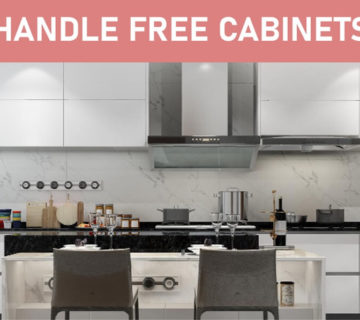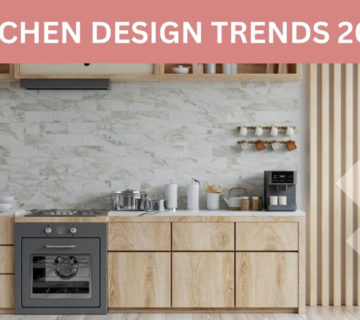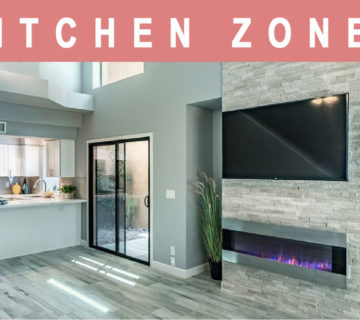Avoid These Common
Kitchen Remodeling Mistakes
Setting out on a kitchen remodeling journey can be both exciting and intimidating, filled with endless choices and critical decisions. Your kitchen is more than a collection of cabinets, countertops, and tile. It’s a space that should reflect your style, inspire culinary creativity, and facilitate day-to-day tasks seamlessly. In this guide, I go into the common pitfalls homeowners encounter when remodeling their kitchen and I’ll explain how to avoid or navigate them. I have grouped my endless list of tips into five areas – layout, design, style, the remodeling process, and functionality. By considering these pain points, you can ensure your kitchen remodeling process is smooth, cost-effective, and results in a kitchen you’ll love. Happy remodeling!

Plan Zones
Efficient kitchen workflow is essential for everyday tasks. Unfortunately, dedicated work zones are often neglected until after a kitchen is remodeled. Each zone should be thoughtfully included in the design to serve a specific purpose, such as food prep areas, mixing zones, and space for specific appliances. Countertop work zones should also incorporate drying areas, spice storage, and oil storage, strategically placed near the cooking or food preparation area. While these details may be overlooked by some, planning ahead is crucial for maximizing the benefits of any kitchen remodel.

Think About Layout
A practical layout is the first thing to consider when redesigning a kitchen. It can be based on your personal preference, but can also take cues from traditional designs, like the classic “triangle” of stove, fridge and sink. Find a layout you like that is easy and practical.


Design And Flow
It's easy to get caught up with trendy kitchen designs in magazines and online. However, it's important to consider which trends will stand the test of time. A well-designed kitchen should prioritize functionality and flow. Think about the best storage spots and the movement within your kitchen. Avoid common mistakes like excessive storage that resembles locker storage. Explore various design options until you find one that meets your expectations. Instead of chasing the latest designs, focus on tried and tested options that work for you. Don't settle for a kitchen that looks perfect but lacks a practical workflow.

Do You Really Need A Bigger Kitchen?
When watching movies and TV shows, it's easy to be amazed by the spacious kitchens that could fit a parade float. We tend to obsess over the idea of having a large kitchen. Unless it's intentionally designed to be oversized work with what you have instead of opting to borrow square footage from other areas of your home. Instead, utilize the current available space to create functional areas and zones that enhance your kitchen activities. If you enjoy hosting and entertaining guests, make that space part of the experience rather than resembling a cooking TV series.

Sketch a Layout
Before you sit down with a designer or contractor have a sketch of what your ideal kitchen could look like. Be sure to think about things like light, angles, balance, symmetry, and the "design triangle". The internet is full of design tools that don't require any CAD experience, in fact, they're so easy to use any DIYer can yield a solid concept for a new kitchen.

Falling Into the “Trend Trap”
To grasp the "Trend Trap," understand the kitchen trend cycle. Currently, the wealthiest remodel homes to be unique, setting style trends. As these styles become popular, prices drop, making them mainstream. The "trap" occurs when a high-end, trendy kitchen is placed in the wrong neighborhood. Will anyone purchasing the home like it in 5 years? If it's too trendy, maybe not.

I refer to this as "working with the bones of the house." Each house, regardless of size, is designed by an architect with a specific style in mind. While these styles can often be mixed and matched, or even changed with minimal construction, sometimes it's not possible. I've witnessed a lot of money wasted on moving walls, rewiring electricity, and even plumbing in attempts to create an open floor plan, only to result in failure. Why? Because you can't work against the house's foundation. Instead, collaborate with a kitchen designer to find a style and design that complements the existing structure.

Find A Good Designer
You might not have the expertise to redesign a whole kitchen or bathroom, but professionals do. Consider investing in a good designer before hiring a contractor. The best designers are knowledgeable about trends, styles, and materials, and can bring your vision to life. Having a designer who understands your needs can streamline the remodel process, saving you time and money. Conduct some basic interior design research before meeting with a designer or contractor.

Kitchen Designer Pitfall
You’ve heard this before, so when it comes to trusting your kitchen designer’s opinion, don’t settle. They use best judgment, but having a firm grasp on your kitchen design and open communication is crucial for a happy marriage in creating the optimal kitchen. Putting faith in your designer is fine, but when it doesn’t match your vision of a dream kitchen, you lose control of what you’re paying for. Without your input, you could end up paying for features that don't add value to your vision.

Not Hiring a Kitchen Designer
The thought of hiring a kitchen designer may seem like an unnecessary expense, but it can ultimately save you time and money in the long run. A professional designer has experience dealing with all types of kitchen designs, materials, and contractors. They can offer expert advice on functionality, aesthetics, and cost-effective solutions that align with your vision. Additionally, a knowledgeable designer will frequently collaborate closely with the contractor to ensure that the approved design is successfully realized.
Before you sit down with a designer or contractor have a sketch of what your ideal kitchen could look like. Be sure to think about things like light, angles, balance, symmetry, and the "design triangle". The internet is full of design tools that don't require any CAD experience, in fact, they're so easy to use any DIYer can yield a solid concept for a new kitchen.

Trendy Designs
Trends come and go, so it's best to avoid designing your kitchen around them. While having a trendy kitchen may be appealing now, it could quickly become outdated in a few years. Instead, opt for classic design elements that will stand the test of time. Timeless design strategy would be to adhere to neutral colors, balanced lighting, and plenty of concealed storage to keep your kitchen looking fresh and functional, regardless of the changing trends. Classic designs are also more attractive to potential buyers if you plan on selling your home in the future.

Too Much Color
While splashes of color can add personality to a kitchen, overdoing it can make the space feel overwhelming and cluttered. When choosing colors for your kitchen, stick to a cohesive color scheme and use pops of color sparingly. Incorporate neutral tones for larger surfaces like cabinets and countertops, then add pops of color through smaller accents like backsplash tiles or accessories. This will create a balanced and visually pleasing kitchen.

Move Over Marble
Marble and natural stone make for luxurious and stunning choices for kitchen countertops. But, let's face it, who has the time to clean up every spill immediately to prevent staining? Quartz manufacturers have come a long way in developing materials that look just like marble. Manufacturers like Teltos, Silestone, and Caesarstone specialize in engineered quartz that looks like marble - providing double the durability at half the price.

Extend Cabinetry To the Ceiling
Leaving a gap between your cabinetry and the ceiling not only gathers dust and grime, but also creates the illusion of a lower ceiling and a more confined space. For a sleeker look without inaccessible areas, consider extending your cabinetry all the way to the ceiling. Upper cabinets offer a place to display items through the use of glass doors, eliminating the need for constant cleaning.

Overboard with Open Shelving
Open shelving has been a trend for the last five years and is still going strong. It's a great way to display your collections or dishes, but it's easy to overdo it. It's important to remember that open shelving isn't the most practical option for storage, and it requires regular upkeep. To strike a balance between symmetry and storage, it's best to have a mix of concealed doors and open shelving.

Friends as Influencers
Seeking advice from friends and family on kitchen remodeling can be helpful, but everyone has their unique way of utilizing their kitchen and their own preferences. The ultimate design decisions should reflect your personal style and needs. As the kitchen is often considered the heart of the home, it should reflect your vision and serve your family well for years to come. Trust your instincts while adhering to solid design principles.

Lighting
Lighting is key when it comes to creating the right ambiance in any room, including your kitchen. A common mistake people make when remodeling their kitchen is not properly considering lighting. Whether it's natural or artificial light, it can drastically change the mood and overall feel of your kitchen. Incorporate a variety of lighting sources, such as recessed lights, hanging lights, and under cabinet lighting, to create a layered and customizable lighting scheme.

Don't Be Fooled, Lighting is an Art
Kitchen lighting goes beyond functionality; it significantly influences the aesthetic and mood. Light can accentuate design elements, create a sense of space and depth, and influence our perception of color. Understanding the interplay of different light fixtures and their placement is crucial for effective kitchen remodeling. A kitchen designer can provide expert guidance on lighting for optimal results.

Adhere to an "Order of Operations"
Planning a kitchen remodel requires a well-established 'Order of Operations' to ensure an efficient and cost-effective renovation. Start with the cabinets, the foundation of your kitchen's appeal. Then, focus on the countertops followed by the floors and backsplash. By following this approach, you can efficiently transform your kitchen without missing any vital components.

Beware of Design Fatigue
As you can see from this guide, a kitchen remodeling project requires consideration of many elements: cabinet style, color, counter style, material, flooring, backsplash, appliances, hardware, and lighting. Design fatigue occurs when trying to make all these decisions at once. The solution? Break them into phases. Begin with the major elements like cabinets, counters, and floors, then gradually address hardware, appliances, and accessories in later phases.

Work With What You Have
Trying to drastically change your kitchen might seem tempting but can be a costly mistake. Adding a kitchen island or pantry may seem great, but could reduce space and functionality. This can lead to layout issues and make a remodel feel burdensome. It's crucial to work within the existing kitchen structure for a balanced look and function without financial strain.

Consider a Cosmetic Remodel
Can you achieve the kitchen you're after without structural changes? If so, consider a cosmetic remodel. This involves upgrading (or even painting) things like cabinets, counters, floors, and backsplash, while leaving walls, HVAC, and plumbing untouched. Construction projects, like tearing down walls or rewiring, significantly increases remodel costs. So, if possible, avoid these expenses with a makeover instead of a complete remodel.

Think Resale Value
The kitchen is often considered the heart of the home and plays a crucial role in real estate. It's a place for cooking, eating, and socializing. A well-maintained, modern kitchen can increase home value, while a dated one can deter buyers. In today's market, buyers prioritize the kitchen due to culinary shows and open-plan living. A well-designed kitchen can command a higher asking price, meeting buyers' needs and reflecting their lifestyle.

Avoid Spending More
Many believe a kitchen remodel requires a significant financial investment, perpetuated since the 1980s when flashy designs led to overspending. However, due to increased design competition, costs have become more reasonable. A minor remodel costs $9,500 to $14,500, while a full-scale renovation averages $22,000 for a small kitchen. Structural changes lead to cost surges, so plan wisely and prioritize needs to avoid unnecessary costs. A well-planned remodel doesn't have to cost a fortune.

Getting More for Less
Even if you're working with a limited budget, there's no need to compromise. While it's important to purchase quaility materials, there are affordable options that are just as visually appealing as their pricier counterparts. By simply swapping out a few items for equally attractive alternatives, you could save yourself hundreds or even thousands of dollars. Kitchen designers possess the artistry to create stunning kitchens on a budget – kitchens that often exceed your initial expectations.

Be Smart About the Cabinets
Kitchen remodeling can significantly enhance your home's value, and your kitchen cabinets play a crucial role in this process. It's possible to find budget-friendly cabinets that mimic the aesthetic of high-end designs. But, be cautious when trying to cut costs too much on cabinets. The least expensive options might be attractive for their price point, but they could be constructed from low-quality materials like particle board or might have sub-par construction standards.

Donating Old Cabinets
If your current cabinets are of decent quality, consider repurposing or donating instead of tossing them. Organizations like Habitat for Humanity and Starlight accept donated cabinets. These cabinets can be of immense value in low-income housing projects and other charitable causes. Not only does this help you declutter and save effort during your remodel, but it also allows you to contribute positively to your community. Truly a win-win scenario!

Choose Your Contractor Carefully
A complete kitchen remodel is a complex and hands-on endeavor that involves managing multiple workmen, tradespeople, and vendors. This process requires careful coordination and scheduling, which can span a month or two. The key is finding the right contractor who can oversee every aspect, ensuring that each tradesperson is scheduled appropriately and that the work is carried out with precision. Ultimately, they become the final authority, ensuring everything is done to perfection.


Changing the Game Plan
Before starting your remodel, it's crucial to have a clear game plan. What are your remodeling goals? What's changing and what's staying the same? Once you've made these decisions, stick with them! Deviating from a solid plan can lead to costly delays. Prepare and commit to your plan to avoid unnecessary headaches and unexpected expenses.

Overly Personalized Remodels
While it might be tempting to remodel your kitchen with a unique, eccentric design that suits your personal style, it's essential to consider the long-term implications, especially if you plan to sell your home in the future. While a Mediterranean or Tuscan-style kitchen may be enchanting to some, such specialized designs may not appeal to the majority of potential buyers. Overly personalized kitchens can limit buyer interest and potentially affect the overall market value of your home.

A Kitchen That Dances to Your Tune
Great kitchen design goes beyond cooking, blending seamlessly with entertainment, family bonding, and memory-making. Picture a space that caters to your culinary skills and lifestyle needs, from Sunday pancakes to holiday feasts. Carefully consider appliance placement, comfortable seating, and versatile lighting to transform your kitchen into a hub for practical needs and joy-filled moments. Strive to create a kitchen that not only 'works with you' but also 'connects you' to loved ones, passions, and memorable moments.

Consider Your Culinary Preferences
Keep in mind the specific appliances, storage needs and layout that will best support your unique culinary style. For instance, baking or pasta lovers might want ample countertop space for rolling out dough. Seafood enthusiasts might focus on easy-to-clean surfaces and a powerful ventilation system to tackle lingering aromas. Meat lovers, might opt for a dedicated convection oven installed at eye level. Your kitchen should not only make cooking easier but also reflect who you are as a cook.

Navigating the Appliance Maze
Consider how appliances will be stored and handled to ensure both functionality and aesthetics. Pre-plan the placement and storage of appliances for daily and less frequent use, balancing countertop appliances with overall kitchen design. Balance personal preferences and lifestyle needs, opt for stylish yet practical appliances, and maximize functionality in a limited space.

A common kitchen remodeling mistake is focusing solely on the design and aesthetic appeal while neglecting storage options. A well-designed kitchen should not only look beautiful, but also provide efficient storage solutions to keep your space organized and clutter-free. Think outside the box and utilize space wisely - from vertical shelving, slide-out spice storage organizers, to pull-out pantry shelves, there are many creative options to maximize storage.

Common Storage Fails
When planning storage in your kitchen remodel, aim for functionality as well as aesthetics. Consider ease of access and practical use of spaces. Avoid placing storage areas in hard-to-reach corners and ensure cabinets are at a practical height. Consider open shelves for frequently used items and larger storage spaces for small appliances and bulkier items. Remember, a well-organized kitchen not only looks good but also enhances your cooking experience by making everything readily available.

Consider Rollout Cabinets
One overlooked storage solution are rollout cabinets. These provide easy access to items in the back of deep or corner cabinets, eliminating the need to awkwardly reach and rummage through cluttered shelves. They also maximize vertical space by utilizing the full height of your cabinets for storage. Rollout trays can be added to base cabinets as well, making pots, pans and other heavy items easier to access and reducing strain on your back.

Consider Hidden Storage
An easy solution to common storage failures is installing hidden cabinets. These types of storage are built into the walls, taking up minimal space while offering a large capacity for storing heavier and larger appliances. Hidden cabinets can blend in with your kitchen's overall design, or be completely concealed behind a cabinet door.

Intentional Power Planning
Strategic placement of electrical outlets is crucial. Consider your kitchen usage - avid cooks need outlets near prep stations for food processors or mixers, while families benefit from USB outlets for device charging. Outlets under kitchen islands can be a clever solution, but ensure they are recessed and covered. Pop-up outlets offer functionality without compromising aesthetics. Consider appliance power ratings to ensure circuits can handle the load.














No comment